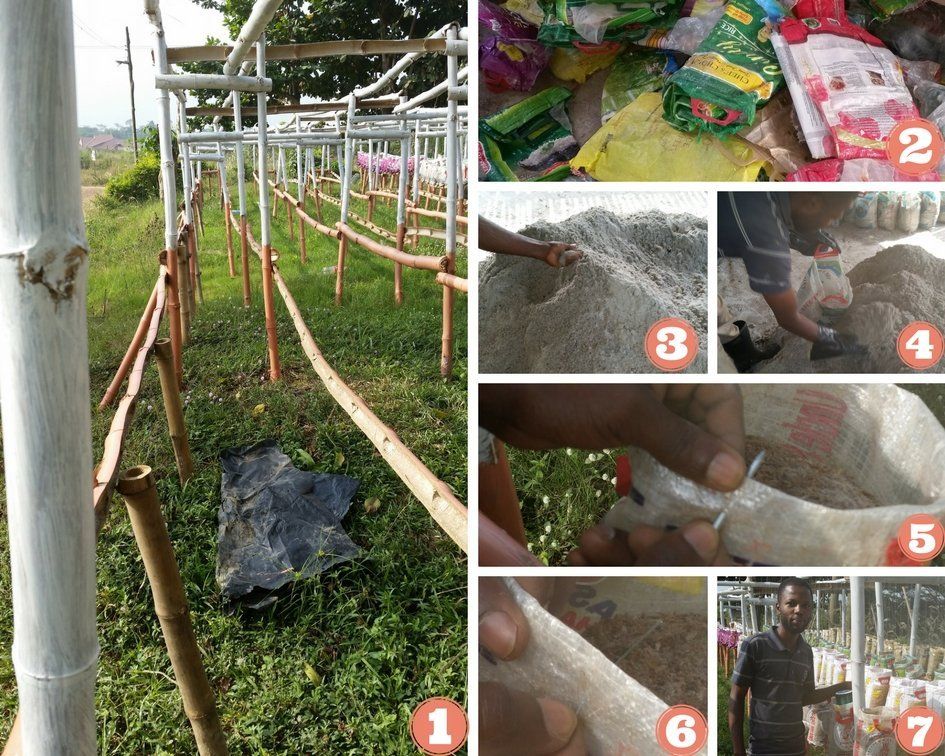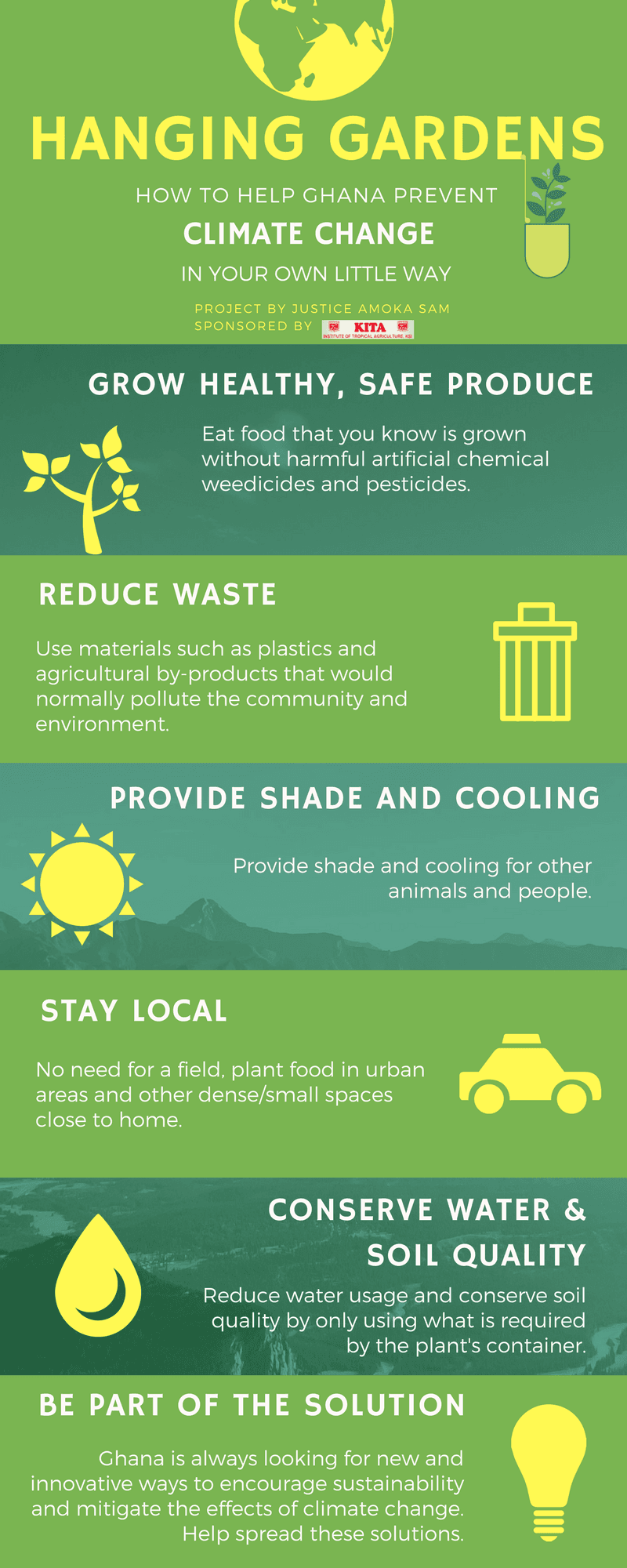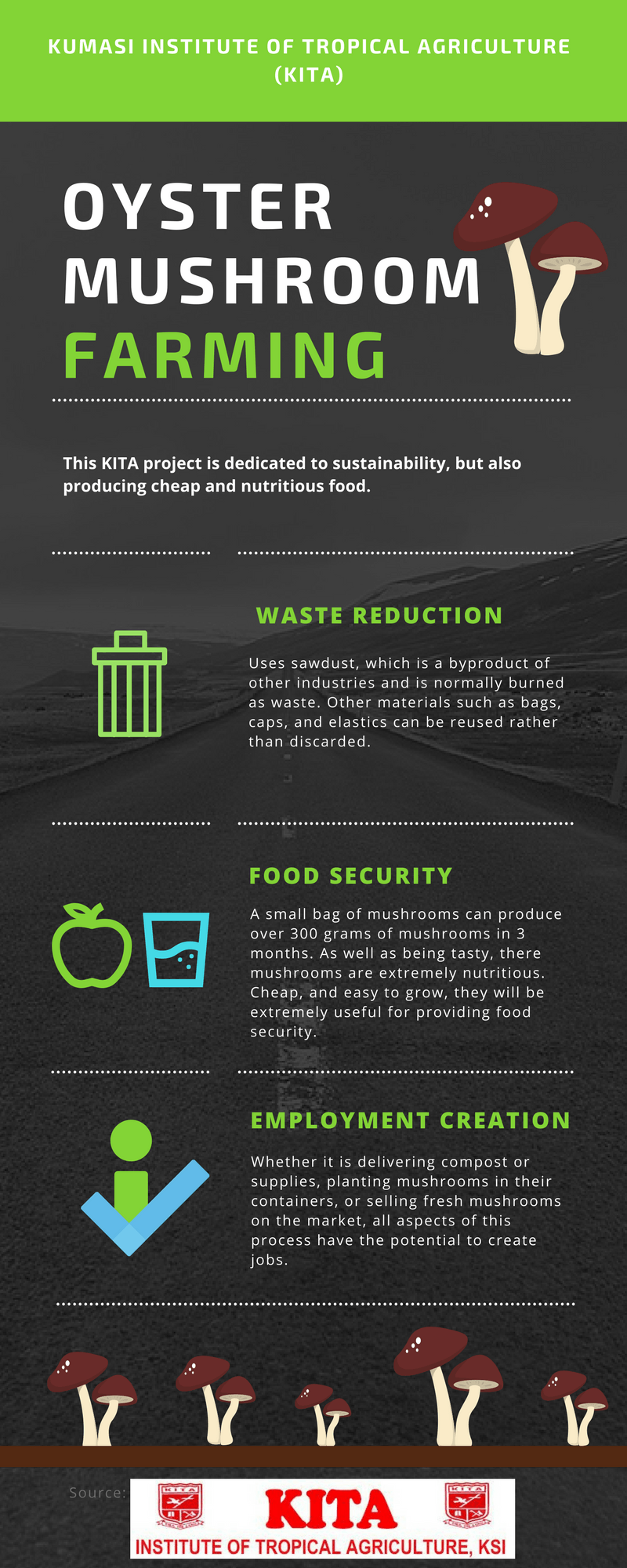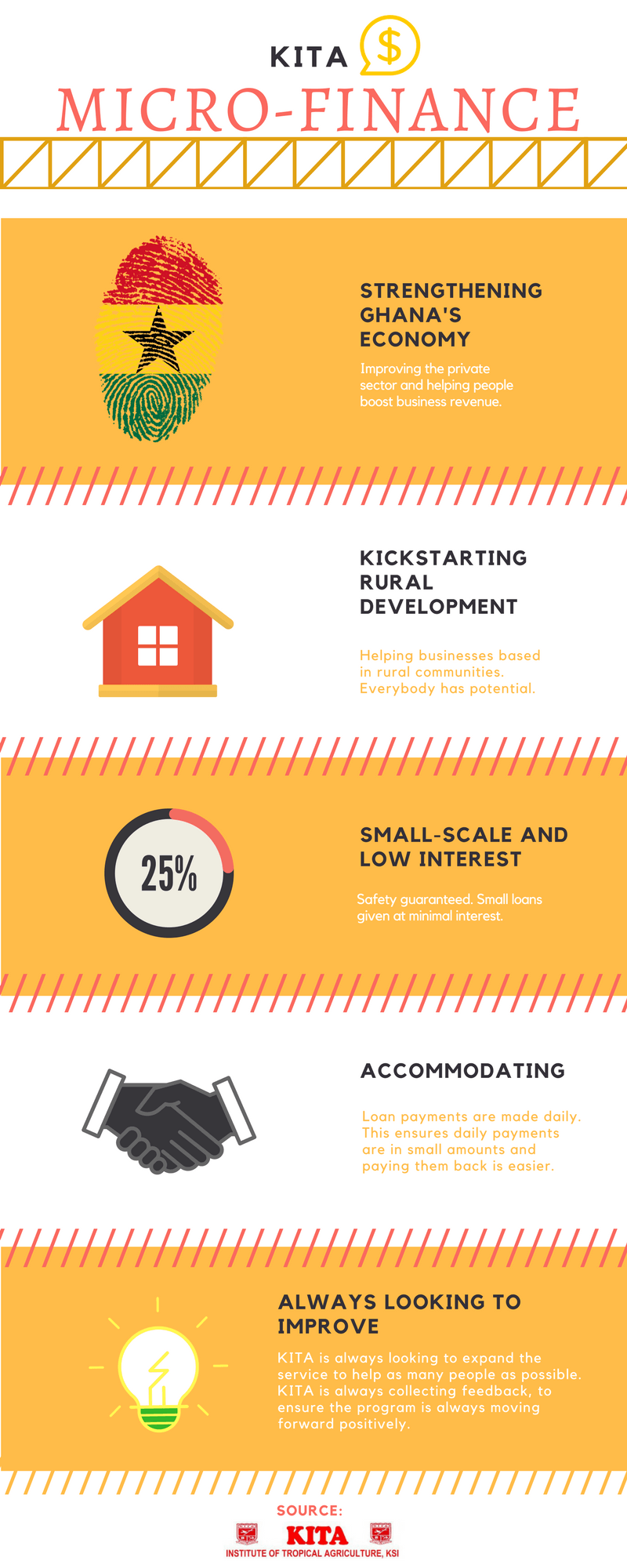The Hanging Garden
- By Kamal Mirani
- •
- 11 Jan, 2018
- •
How it started:
As his hanging garden grows in size, so does its impact on the surrounding community and environment. Every day, KITA Level 300 student Justice Amoka Sam wakes up in the morning and begins completing the necessary steps to suspend a growing plant above the ground. A Hanging Garden is part of Justice’s innovative solution of mitigating the effects of climate change, while also encouraging urban agriculture and sustainability.
While a Hanging Garden can be used for many purposes, Justice was specifically inspired by a local experience. When he saw a farmer spraying his cabbage field with chemical pesticide, he realized that everyone who purchased cabbage from this farmer would be ingesting a degree of pesticide; unbeknownst to them. While Justice designed his system to eliminate the use of chemicals, it has also proved helpful in solving other problems.
Climate change and the need for Sustainability:
As the effects of climate change grow more severe, Ghana must continue to look for new and innovative ways to encourage sustainability. These Hanging Gardens exemplify the types of solutions that are needed to change the way Ghanaians interact with their community and environment. The Hanging Garden uses plastic containers or sacs to grow plants. These plastic items would normally end up in the garbage (assuming that they have not been recycled) where they will pollute the landscape and waterways, ironically making it even more difficult for other plants and animals to thrive. This Garden encourages the use of sustainable soil mediums. Justice himself is currently using rice husk and ash as a medium, the natural byproducts of items that would have normally been discarded. Similarly with the plastics, if these natural byproducts were to be discarded, they would also end up polluting the local environment. As cities and towns grow larger, the amount of good land available for farming decreases. These Gardens seek to make maximum use of available space by disregarding the need to plant crops in the field. By growing plants in containers that do not require lots of space (like a field), houses, streets, and other structures all have the potential to become farms. Justice himself likes to raise chickens beneath his hanging gardens, enabling him to farm vegetables and protein, truly maximizing the use of his space.
Built-up areas (high density, full of buildings) are typically much hotter than the surrounding area, due to construction materials such as wood and concrete trapping heat. These gardens have another purpose, by providing shade and cooling the general vicinity; both people and animals are able to benefit from this. In this sense, there is really no excuse for not being able to plant your own crops with this cost and space effective solution. Linking back to Justice’s original goal of avoiding use of chemicals, there is nothing safer than eating from a source you know, and hopefully with time, more Ghanaians will be implementing innovative solutions such as this to increase the safety of their food, as well as to reduce the stress placed on their community, environment, and climate.
Re-usability:
All of these aspects are reusable, the structure, the container, even the medium (though it may need to be sterilized after 5 or 6 uses). The only thing that will need to be replaced are the seeds (after the plants have been harvested and they start to lose their yield).
As his hanging garden grows in size, so does its impact on the surrounding community and environment. Every day, KITA Level 300 student Justice Amoka Sam wakes up in the morning and begins completing the necessary steps to suspend a growing plant above the ground. A Hanging Garden is part of Justice’s innovative solution of mitigating the effects of climate change, while also encouraging urban agriculture and sustainability.
While a Hanging Garden can be used for many purposes, Justice was specifically inspired by a local experience. When he saw a farmer spraying his cabbage field with chemical pesticide, he realized that everyone who purchased cabbage from this farmer would be ingesting a degree of pesticide; unbeknownst to them. While Justice designed his system to eliminate the use of chemicals, it has also proved helpful in solving other problems.
Climate change and the need for Sustainability:
As the effects of climate change grow more severe, Ghana must continue to look for new and innovative ways to encourage sustainability. These Hanging Gardens exemplify the types of solutions that are needed to change the way Ghanaians interact with their community and environment. The Hanging Garden uses plastic containers or sacs to grow plants. These plastic items would normally end up in the garbage (assuming that they have not been recycled) where they will pollute the landscape and waterways, ironically making it even more difficult for other plants and animals to thrive. This Garden encourages the use of sustainable soil mediums. Justice himself is currently using rice husk and ash as a medium, the natural byproducts of items that would have normally been discarded. Similarly with the plastics, if these natural byproducts were to be discarded, they would also end up polluting the local environment. As cities and towns grow larger, the amount of good land available for farming decreases. These Gardens seek to make maximum use of available space by disregarding the need to plant crops in the field. By growing plants in containers that do not require lots of space (like a field), houses, streets, and other structures all have the potential to become farms. Justice himself likes to raise chickens beneath his hanging gardens, enabling him to farm vegetables and protein, truly maximizing the use of his space.
Built-up areas (high density, full of buildings) are typically much hotter than the surrounding area, due to construction materials such as wood and concrete trapping heat. These gardens have another purpose, by providing shade and cooling the general vicinity; both people and animals are able to benefit from this. In this sense, there is really no excuse for not being able to plant your own crops with this cost and space effective solution. Linking back to Justice’s original goal of avoiding use of chemicals, there is nothing safer than eating from a source you know, and hopefully with time, more Ghanaians will be implementing innovative solutions such as this to increase the safety of their food, as well as to reduce the stress placed on their community, environment, and climate.
Re-usability:
All of these aspects are reusable, the structure, the container, even the medium (though it may need to be sterilized after 5 or 6 uses). The only thing that will need to be replaced are the seeds (after the plants have been harvested and they start to lose their yield).
Do-it-yourself

More about KITA:
The Kumasi Institute of Tropical Agriculture (KITA) is a non-profit premier tropical agricultural college in Ghana. We network with: local and global institutions to better the lives of rural farmers, unemployed youth, hungry and homeless families, women, AIDS victims and orphans, needy street children, the aged, and the disabled. This is done through: training, seminars and workshops, technology transfers, on-farm research, environmental conservation, volunteer exchange, seeds and food aid, input and clothing distribution and children’s sponsorship. This has contributed to environmentally sustainable development that enhances the local economy, the nation, and the quality of life in Africa since 1984.
KITA has sponsored this Hanging Garden project by covering the expenses of the materials, as well as a portion of the educational fees of the students who are involved.
The Kumasi Institute of Tropical Agriculture (KITA) is a non-profit premier tropical agricultural college in Ghana. We network with: local and global institutions to better the lives of rural farmers, unemployed youth, hungry and homeless families, women, AIDS victims and orphans, needy street children, the aged, and the disabled. This is done through: training, seminars and workshops, technology transfers, on-farm research, environmental conservation, volunteer exchange, seeds and food aid, input and clothing distribution and children’s sponsorship. This has contributed to environmentally sustainable development that enhances the local economy, the nation, and the quality of life in Africa since 1984.
KITA has sponsored this Hanging Garden project by covering the expenses of the materials, as well as a portion of the educational fees of the students who are involved.




